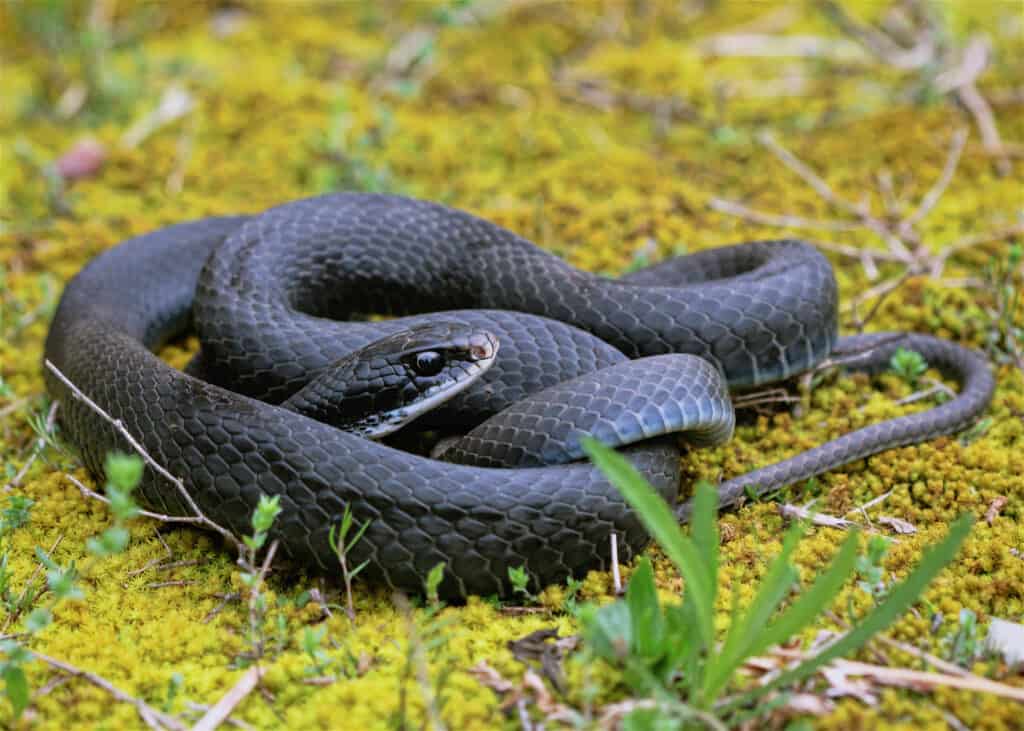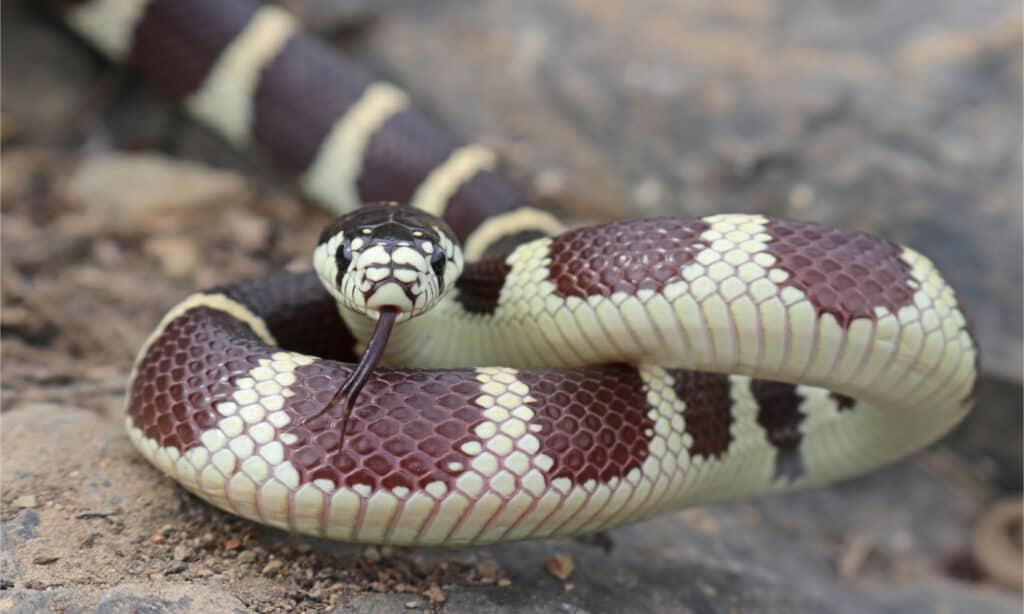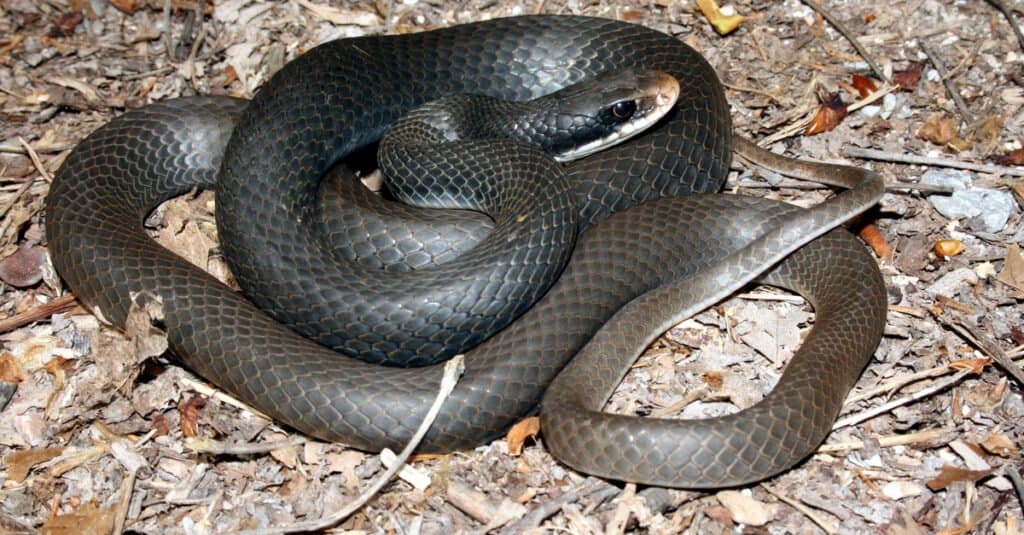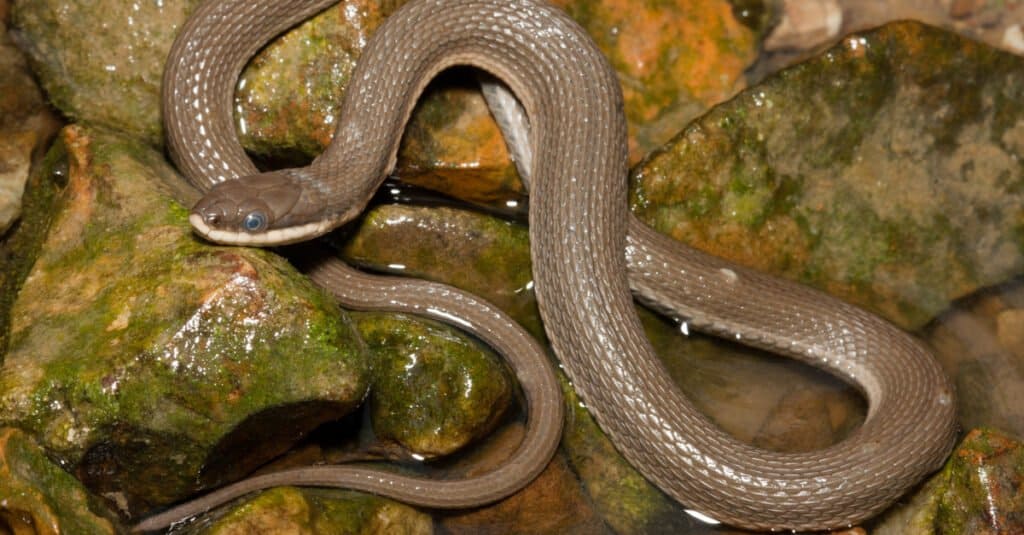Key Points:
- Each snake in this guide is categorized by its appearance, range, habitat, diet, and danger level.
- Black and brown are the most common colors that a snake could have in the United States.
- The eastern garter snake, yellow rat snake, California kingsnake, southern black racer, and queen snake are all included in this guide.
Finding a snake in your yard is almost inevitable in many parts of the United States, especially as summer and spring arrive. When it comes to snakes, part of being safe and doing the right thing is knowing what kind of snake you are looking at.
Today, we are going to help you identify the most common black snakes with white stripes in the U.S. While this isn’t a complete list (there are more than 3,000 species of snakes out there, you know), it will probably cover the most likely culprits that you could find slithering into your yard.
Black Snake With White Stripes
Black and brown are probably the most common colors that a snake could have, especially in the U.S.
Thankfully, adding the secondary feature of “white stripes” really narrows things down. In order to keep things neat and categorized, we have broken down each species of black snake with white stripes into a few key elements:
- Appearance
- Range
- Habitat
- Diet
- Danger level.
Using this guide, you can easily identify the black snake with white stripes you found in your yard or while on a hike. Let’s get started.
How Common Is Black and Brown Coloring in Snakes?

Racers eat small animals like rodents, frogs, toads, lizards, birds, and bird eggs.
©Matthew L Niemiller/Shutterstock.com
Snakes are some of the most diverse and fascinating creatures on the planet. They come in a wide variety of colors, patterns, and sizes, each adapted to their unique environments and lifestyles. One of the most striking features of snakes is their coloration. While many snakes are known for their bright and bold colors, others exhibit more muted hues like black and brown. But just how common are black and brown coloring in snakes?
The black and brown coloration is actually quite common in snakes, and they can be found in a variety of species across the world. In fact, many snake species have evolved to have black or brown scales as a way of blending in with their surroundings and avoiding detection by predators or prey.
In North America, for example, several species of venomous snakes such as the copperhead and cottonmouth are predominantly brown or black in color, with various patterns of lighter and darker scales. These patterns help them blend into the leaf litter and other debris on the forest floor, making them harder to spot by predators and prey alike.
Eastern Garter Snake

Garter snakes are some of the most common species of snake seen in the U.S.
©Erik Agar/Shutterstock.com
The eastern garter snakes (and all other species of garter snakes) are some of the most common snakes you can find in the United States. They come in quite a few colorations, but black is one of the most common ones. These common snakes are often seen in gardens, which is why people incorrectly refer to them as “garden snakes.”
Appearance: Black, grey, or brown bodies. Three longitudinal stripes running from head to tail that can be yellow or white. Occasionally come in a more checkered pattern, generally found on lighter-colored snakes. Can grow to 5 feet in length.
Range: Most of the eastern United States, primarily in the south.
Habitat: Meadows, marches, woodlands, forests, and suburban areas.
Diet: Worms, slugs, frogs, toads, and salamanders.
Danger Level: Low. Nonvenomous, but will strike if overhandled.
Yellow Rat Snake

There are many types of rat snakes, but the black and yellow subspecies are most likely to be black with white stripes.
©iStock.com/RCKeller
The yellow rat snake is probably the second most likely snake you will see in your yard. This long snake can grow over 6 feet long and is easily confused with the eastern garter snake. Rat snakes are slightly more distributed than garter snakes, however.
Appearance: Black bodies with faint white or yellow colorations between the scales. Different species of rat snakes can have four black stripes running down their backs, especially the yellow rat snake. Lighter-colored belly, usually cream or white.
Range: Most of the southeast, northeast, and into midwest.
Habitat: Almost all habitats. Hills, forests, abandoned buildings, barns, suburbs, fields.
Diet: Mice, rats, squirrels, birds, eggs.
Danger Level: Low. Nonvenomous, but will release a musky odor when threatened.
California Kingsnake

The California kingsnake has a vast variety of solid colors with stripes.
©Creeping Things/Shutterstock.com
The California kingsnake is one of the prettiest snakes on our list and is, as the name shows, found in California. Kingsnakes are common across much of the United States and they come in a large variety of colors. Additionally, California kingsnakes are often kept as pets because of their famed mild nature.
Appearance: Vast variety of solid colors with stripes. Often white with strong black stripes or black with strong white stripes. Can grow up to 4 feet in length.
Range: Southwestern states and into Baja Mexico, California coast up through Oregon.
Habitat: Adaptable. Often found in woodlands, forests, grasslands, fields, and deserts.
Diet: Other snakes (including venomous ones), rodents, lizards, frogs, and birds.
Danger Level: Low. Nonvenomous and known for their mild disposition. Often kept as pets.
Common Kingsnake

The common kingsnake has a black body with strong white stripes.
©iStock.com/JasonOndreicka
There are a few species of kingsnake, and the common kingsnake is often known as the eastern kingsnake. Similar to the California kingsnake, these amazing animals are called the “king” because of their diets that mainly consist of other snakes. Although they come in different colors and patterns, eastern kingsnakes are often black and white.
Appearance: Black bodies with strong white stripes. Can grow up to 4 feet in length.
Range: Eastern United States
Habitat: Anywhere from the ocean to the mountains and anywhere in between.
Diet: Other snakes (including venomous ones), rodents, lizards, frogs, and birds.
Danger Level: Low. Nonvenomous and known for their mild disposition. Often kept as pets.
Southern Black Racer

Black racers are usually solid black, but their white underbellies can make them appear striped.
©Psychotic Nature/Shutterstock.com
The Southern black racer is named after its ability to slither incredibly fast. These common snakes are long and thin and can be found in most places across the united states. An interesting fact is that they really don’t like being handled, even after spending months in captivity. When handled, they will strike and release a foul-smelling musk.
Appearance: Long, thin bodies with jet-black backs. Grey bellies with white chins. Can grow up to 5 feet in length.
Range: Eastern United States from the Florida Keys up through Maine. Other species of racer are found in different parts of the U.S.
Habitat: Forests, woodlands, meadows, prairies, sandhills, and deserts.
Diet: Lizards, insects, mammals, eggs, small snakes, eggs.
Danger Level: Low. Nonvenomous, but won’t tolerate being handled. Can release a foul-smelling odor.
Queen Snake

Queen snakes are brown, grey, or olive with clear stripes on their bellies.
©Nathan A Shepard/Shutterstock.com
The queen snake is a semi-aquatic snake species that goes by a great many names (banded water snake, brown queen snake, diamond-back water snake, leather snake, and moon snake, just to name a few). Although it can look extremely similar to a garter snake, a quick look at the belly is a great way to tell the difference between the two. Queen snakes have stripes on their belly while garter snakes do not.
Appearance: Black, olive, grey, or dark brown bodies. Peach, yellow, or stained white stripes running down its back, with similar stripes running down its belly. Can grow up to 2-3 feet in length.
Range: Piedmont and mountainous regions of the eastern U.S. and into the midwest from the Great Lakes to Louisiana.
Habitat: Aquatic snakes that can be found near streams, ponds, and more.
Diet: Crayfish, fish, and small aquatic animals.
Danger Level: Low. Non-venomous, but will release a foul-smelling odor if mishandled.
The photo featured at the top of this post is © Matt Jeppson/Shutterstock.com
Discover the "Monster" Snake 5X Bigger than an Anaconda
Every day A-Z Animals sends out some of the most incredible facts in the world from our free newsletter. Want to discover the 10 most beautiful snakes in the world, a "snake island" where you're never more than 3 feet from danger, or a "monster" snake 5X larger than an anaconda? Then sign up right now and you'll start receiving our daily newsletter absolutely free.
Thank you for reading! Have some feedback for us? Contact the AZ Animals editorial team.






